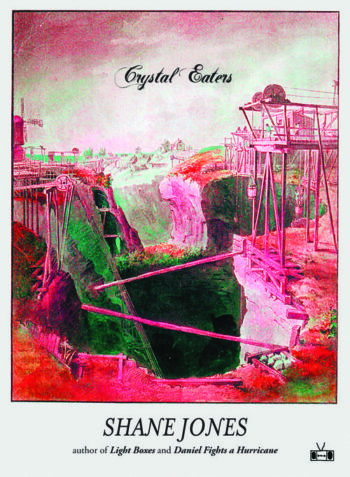
The first thing you notice about Crystal Eaters is the numbers. The book begins with Chapter 40, on page 183. The first line is “It feels good to believe in one hundred.”
After the first page, though, it becomes clear that the numbers are part of a motif of counting down, addiction, a journey, and ultimately death. Crystal Eaters is full of the expectation of death. The book’s primary setting is a village where the residents believe that everyone is born with one hundred crystals inside of them. With each broken bone or illness, they lose some of those crystals, and when the crystals run out, they die. Remy, one of the main characters, is searching for a way to reverse the process, to add crystals to her mother’s life, while others are seeking a way to live forever.
The book lulls you into a false sense of security. Crystal Eaters is described as a sci-fi fable, and it certainly is that. In the first twenty pages we’re shown a city that appears to be autonomously expanding to encompass the village, and this expansion is occurring at the same time as a massive heat wave. The city “lives like it will never die,” and “will bury the village in drywall, coffee shops, and wifi.” The parallels that Jones sets up here are blunt and heavy-handed: the relationship between city and village is a microcosm of civilization’s advancement, complete with global warming and cultural gentrification. Crystal Eaters then dismisses those parallels just as quickly as it draws them. The book’s fable-like, almost YA-dystopian aspects are shattered by Palahniuk-esque bursts of raw, uncomfortable violence. (Palahniuk’s Survivor also uses page numbers as a countdown.) In a jumble of scenes with televisions and vehicles and a nod to The Fresh Prince of Bel-Air, the line between village and city becomes blurry, and this bothered me at first. But as the plot unfolds into a whirlpool of uncertainty, this ambiguity makes sense.

Crystal Eaters has two big things going on that allow it to blend fable and postmodern unreliability. The first is Remy, the child who narrates much of the book. Remy’s voice is simultaneously precocious and innocent, an echo of Safran Foer’s Oskar from Extremely Loud and Incredibly Close, although (thankfully) a little more restrained. Remy asks the reader questions that kind of tear into you, like “What do you name a dog after your first dog dies?” and sets up a perspective where the family dog has a name but Mom and Dad never do. Remy is powerless in the face of the events in the story, but this doesn’t bother her. Instead, what shakes her world upside down is her realization that the adults in the story are just as impotent as she is. Remy’s complement is her brother Adam, a character who has been broken down but still seeks redemption from his cell in the city prison where he goes by the alias “Pants.”
The second thing that makes Crystal Eaters work so well is Jones’ exquisitely accurate command of language and imagery. Whether it’s a spitting cloth being used to “expel the color red,” “dried shit in the shape of a hammered butterfly,” or a boy who “became a little anxious monster waiting for Dad’s anger to liquefy out and onto his body,” Crystal Eaters is full of sentences that jump at you like a pop-up book, painting a world that is at some times painfully real, and at others an exercise in vivid hallucinations.
In an interview (which you should read, by the way, if only for the comparison between publishing giant Penguin and boutique publisher Two Dollar Radio), Jones said he was thinking a lot about video games while writing this book. This makes sense on multiple levels. Several of the characters are on a singular quest throughout the work. Crystals are a surrealistic stand-in for life, blood, and drugs. The villains of the city are mostly faceless, and many. The whole world has a menacing vibe; even the charity organization, a thinly veiled agent of cultural assimilation, is named the “Mob of Mary.”
Crystal Eaters is a dense, high-energy read, despite being fairly short. Its breadth of topics is exhilarating. Jones is pushing genres here, not unlike George Saunders or Karen Russell, but using a harsher lens. Crystal Eaters grabs your face and pushes it up against a fantastic, sprawling, impressionistic painting of death and family.




